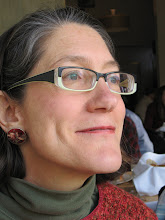Andrew Laws read his poem "Nigger (To Call Myself a Man), a poem that asked, "Who am I can call myself a man?" when the narrator is disempowered to such an extent that he has been "Whipped/ Burned/ Branded/Bruised/Beaten and battered." The poem ends with, "I am nothing/But a nigger."

Alannah Caldwell read her poem "Are We Slaves - Then or Now," in which she challenges our notions of what makes us slaves," and showing that African Americans are just as much enslaved by popular culture as they were with chains.

Dennis Carroll read his poem "A Peace of Mind," the mind of a slave who came over on the ships and whose mind is only a "piece" until the end of the poem when his "piece of mind" becomes a "peace of mind" because of the bond he share with other African Americans who share the same ancestry and history.

Latia, a student who showed us photographs of her white mother, read her poem called "Undefeated," a passionate poet in which she looks at her identity, claiming her "ancestors, to whom she "is forever bonded together" because "we are strong" "born to endure."

Desiree Rivers depicted "Four Women," written by Nina Simone, a song she spoke as she moved from Aunt Sarah to Saffronia to Sweet Thing to Peaches, all versions of African American women. She memorized and spoke the words as she moved seamlessly from one depiction to the next, changing costumes and attitudes as the posture and representation of the women changed. Here she is Aunt Sarah, followed by Sweet Thing.
Here she is Aunt Sarah, followed by Sweet Thing. Hong's focus was a portrait of a woman with mixtures of races and colors. gray in the middle of her face to represent the time when we all meld into one color and one race. His project was inspired by William Wells Brown's novel Clotel: Or The President's Daughter.
Hong's focus was a portrait of a woman with mixtures of races and colors. gray in the middle of her face to represent the time when we all meld into one color and one race. His project was inspired by William Wells Brown's novel Clotel: Or The President's Daughter. Catherine stitched the most imaginative, creative quilt with images of W.E.B. Du Bois's veil, flying slaves from the Vernacular tradition of folk tales, Harrient Jacobs' Incidents in the Life of a Slave Girl and others. Many of these images were sewn inside windows of a house that held many of the authors and stories we've read.
Catherine stitched the most imaginative, creative quilt with images of W.E.B. Du Bois's veil, flying slaves from the Vernacular tradition of folk tales, Harrient Jacobs' Incidents in the Life of a Slave Girl and others. Many of these images were sewn inside windows of a house that held many of the authors and stories we've read.
 Here she is Aunt Sarah, followed by Sweet Thing.
Here she is Aunt Sarah, followed by Sweet Thing. Hong's focus was a portrait of a woman with mixtures of races and colors. gray in the middle of her face to represent the time when we all meld into one color and one race. His project was inspired by William Wells Brown's novel Clotel: Or The President's Daughter.
Hong's focus was a portrait of a woman with mixtures of races and colors. gray in the middle of her face to represent the time when we all meld into one color and one race. His project was inspired by William Wells Brown's novel Clotel: Or The President's Daughter. Catherine stitched the most imaginative, creative quilt with images of W.E.B. Du Bois's veil, flying slaves from the Vernacular tradition of folk tales, Harrient Jacobs' Incidents in the Life of a Slave Girl and others. Many of these images were sewn inside windows of a house that held many of the authors and stories we've read.
Catherine stitched the most imaginative, creative quilt with images of W.E.B. Du Bois's veil, flying slaves from the Vernacular tradition of folk tales, Harrient Jacobs' Incidents in the Life of a Slave Girl and others. Many of these images were sewn inside windows of a house that held many of the authors and stories we've read.

No comments:
Post a Comment